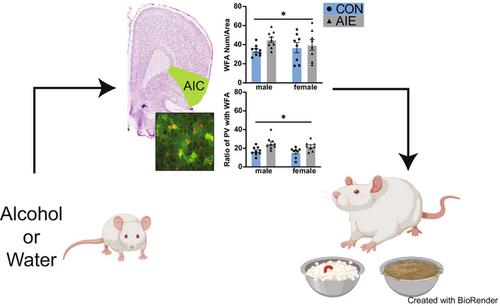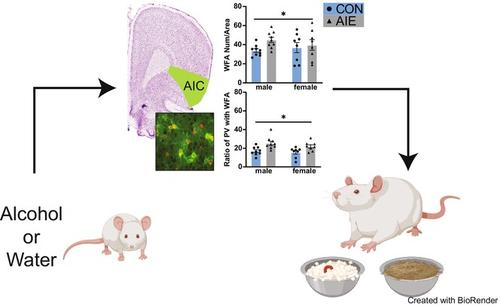Effects of adolescent intermittent ethanol exposure on cortical perineuronal net and parvalbumin expression in adulthood mediate behavioral inflexibility
Abstract
Background
Alcohol is commonly consumed by adolescents in a binge-like pattern, which can lead to long-lasting cognitive deficits, including reduced behavioral flexibility. We and others have determined that adolescent intermittent ethanol (AIE) exposure leads to increased number of perineuronal net (PNN) numbers in brain regions that are important for behavioral flexibility. However, whether altered neurochemistry stemming from AIE exposure plays a significant role in reduced behavioral flexibility is unknown.
Methods
We measured the number and size of parvalbumin expressing (PV+) interneurons and associated PNNs within the orbitofrontal cortex (OFC), prelimbic cortex (PrL), infralimbic cortex (IL), and anterior insular cortex (AIC) of female and male rats following AIE or control exposure and subsequent training on an attentional set-shift task (ASST). We then ran analyses to determine whether AIE-induced changes in PV and PNN measures statistically mediated the AIE-induced behavioral deficit in reversal learning.
Results
We demonstrate that AIE exposure impaired behavioral flexibility on reversal two of the ASST (i.e., recalling the initial learned associations), and led to smaller PV+ cells and increased PNN numbers in the AIC. Interestingly, PNN size and number were not altered in the PrL or IL following AIE exposure, in contrast to prior reports. Mediation analyses suggest that AIE alters behavioral flexibility, at least in part through changes in PV and PNN fluorescent measures in the AIC.
Conclusions
This study reveals a significant link between AIE exposure, neural alterations, and diminished behavioral flexibility in rats, and highlights a potential novel mechanism comprising changes in PV and PNN measures within the AIC. Future studies should explore the impact of PNN degradation within the AIC on behavioral flexibility.



 求助内容:
求助内容: 应助结果提醒方式:
应助结果提醒方式:


